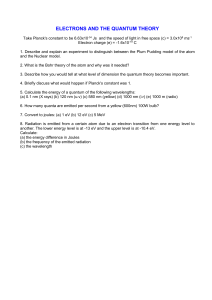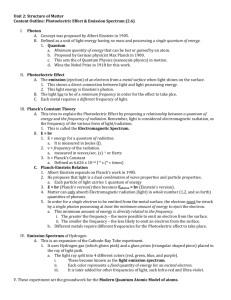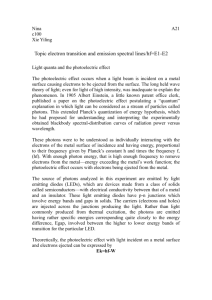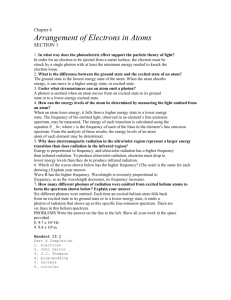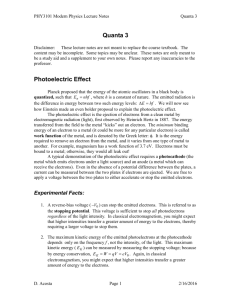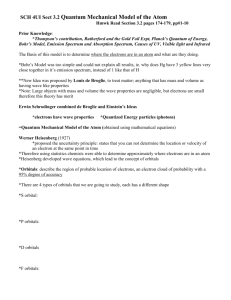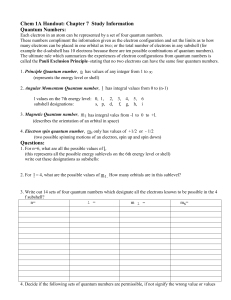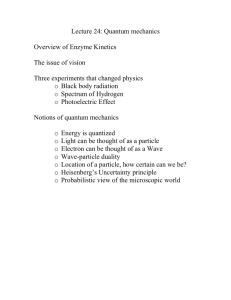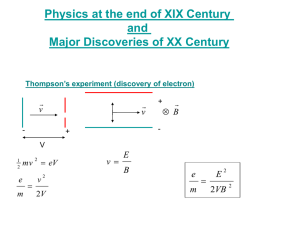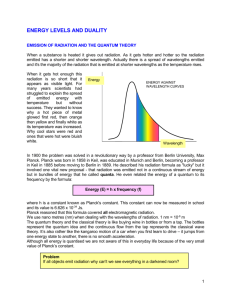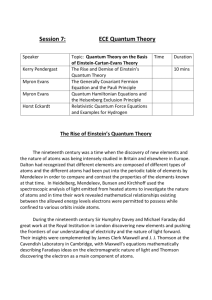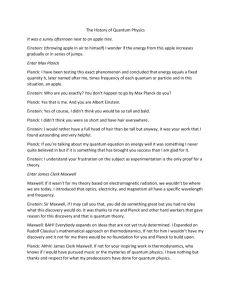Max Planck and Quantum Theory
advertisement
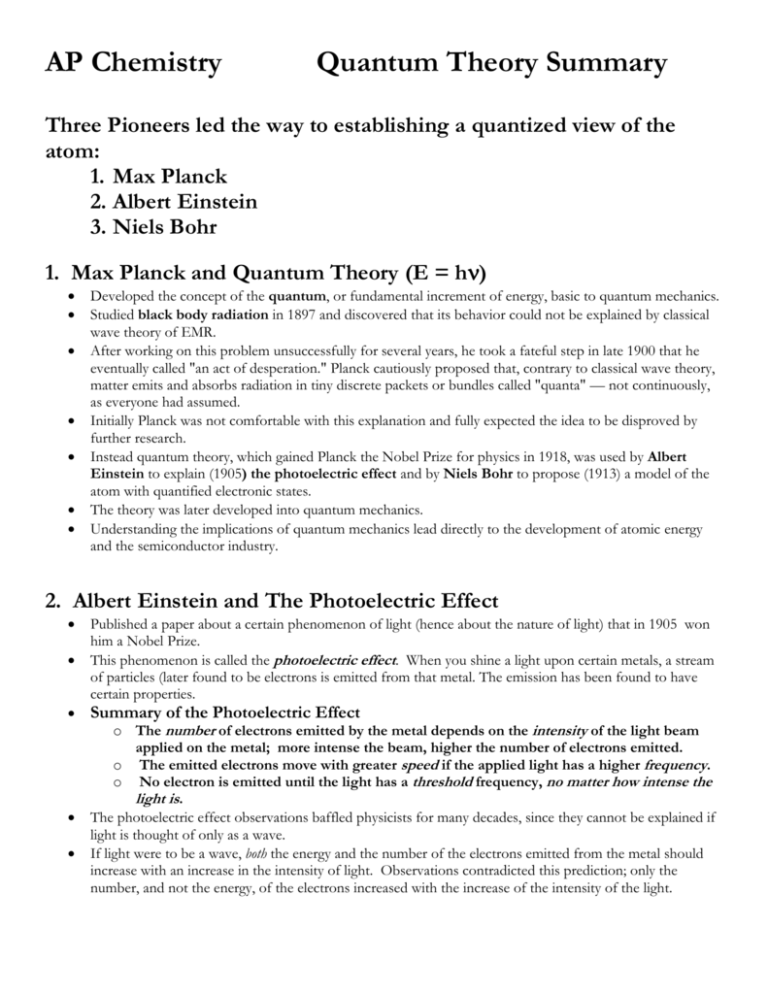
AP Chemistry Quantum Theory Summary Three Pioneers led the way to establishing a quantized view of the atom: 1. Max Planck 2. Albert Einstein 3. Niels Bohr 1. Max Planck and Quantum Theory (E = h) Developed the concept of the quantum, or fundamental increment of energy, basic to quantum mechanics. Studied black body radiation in 1897 and discovered that its behavior could not be explained by classical wave theory of EMR. After working on this problem unsuccessfully for several years, he took a fateful step in late 1900 that he eventually called "an act of desperation." Planck cautiously proposed that, contrary to classical wave theory, matter emits and absorbs radiation in tiny discrete packets or bundles called "quanta" — not continuously, as everyone had assumed. Initially Planck was not comfortable with this explanation and fully expected the idea to be disproved by further research. Instead quantum theory, which gained Planck the Nobel Prize for physics in 1918, was used by Albert Einstein to explain (1905) the photoelectric effect and by Niels Bohr to propose (1913) a model of the atom with quantified electronic states. The theory was later developed into quantum mechanics. Understanding the implications of quantum mechanics lead directly to the development of atomic energy and the semiconductor industry. 2. Albert Einstein and The Photoelectric Effect Published a paper about a certain phenomenon of light (hence about the nature of light) that in 1905 won him a Nobel Prize. This phenomenon is called the photoelectric effect. When you shine a light upon certain metals, a stream of particles (later found to be electrons is emitted from that metal. The emission has been found to have certain properties. Summary of the Photoelectric Effect o The number of electrons emitted by the metal depends on the intensity of the light beam applied on the metal; more intense the beam, higher the number of electrons emitted. o The emitted electrons move with greater speed if the applied light has a higher frequency. o No electron is emitted until the light has a threshold frequency, no matter how intense the light is. The photoelectric effect observations baffled physicists for many decades, since they cannot be explained if light is thought of only as a wave. If light were to be a wave, both the energy and the number of the electrons emitted from the metal should increase with an increase in the intensity of light. Observations contradicted this prediction; only the number, and not the energy, of the electrons increased with the increase of the intensity of the light. What Einstein showed was that the photoelectric effect as it had been observed could be explained if individual particles (or quanta) of light were penetrating the metal and knocking electrons loose from atoms. According to Einstein's paper, increasing the intensity of the light increased the number of photons, while the energy of each individual photon remained the same, as long as the frequency of the light remained the same. Therefore the number of electrons emitted would increase, but the energy transmitted to them by the particles of light would remain the same. In one stroke Einstein showed that light is a stream of particles, and also that there was solid evidence for the existence of quanta. His theory could satisfactorily explain all the known properties of the photoelectric effect, and was the first result derived from quantum theory of the interaction between radiation and matter. 3. Niels Bohr and the Quantized Atom Introduced the idea of a Quantized Model of the Atom (Atom can have only certain values of energy called QUANTA) Background of his Quantized Atom Model: Bohr introduced the model to explain the hydrogen emission spectrum (the series of colored lines produced when hydrogen is excited) He proposed that the single electron of hydrogen can circle the nucleus only in allowed paths, or ORBITS. Each orbit corresponds to a different energy level of the electron. The lowest energy level of an electron occurs in the orbit closest to the nucleus, called the GROUND STATE (E1). A specific amount of energy (a quantum equal to the energy difference between two levels) is needed to excite the electron to a higher energy level, called an EXCITED STATE (E2, E3, …). Exciting an electron to a higher state results in a change of energy, E, that is positive. If an electron is excited to a point where it leaves the atom, by definition it has reached the E∞ level and is defined as having zero energy. Since E∞ by definition has zero energy, all energy levels below this (thus all energy levels) possess an energy that is negative. When the electron falls down to a lower energy level, it gives off the excess energy as Electromagnetic Radiation (EMR). If the energy given off has the correct wavelength for our eyes, we see it as visible light. A falling electron has an overall E that is negative. The various transitions between the levels give rise to emission spectra producing different wavelengths of EMR.
